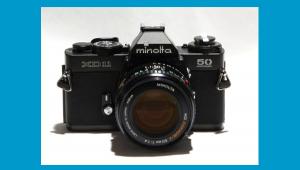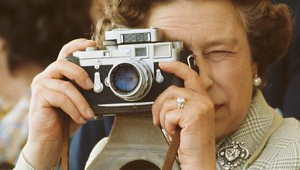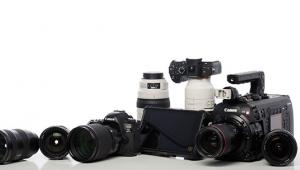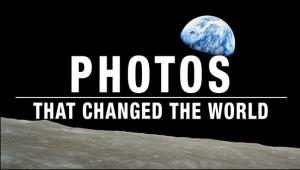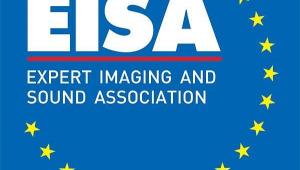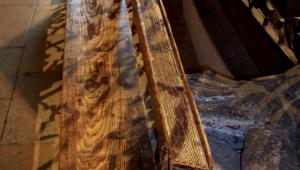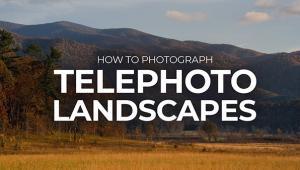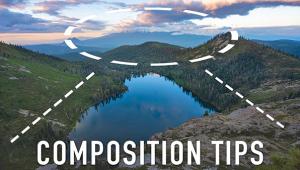Canon Releases The EOS-1D Mark III Digital SLR
Scheduled for initial U.S. shipments in Spring, the estimated selling price of the EOS-1D Mark III Digital SLR will be similar to that of its predecessor, the EOS-1D Mark II N Digital SLR.

See the Whole Picture with a Live View LCD
One of the landmark functions of the EOS-1D Mark III Digital SLR is the introduction
of a Live View shooting mode, tweaked to meet the needs of professional shooters.
Photographers who use point-and-shoot digital cameras are familiar with looking
at the LCD screen on the back of the camera to compose their images. Normally,
a single lens reflex cannot do this because the mirror that lets you look through
the lens is in the way. With the EOS-1D Mark III Digital SLR, a photographer
has several options in addition to conventional SLR through-the-lens viewing.
If the camera is going to be close at hand, the new Live View shooting mode
lets the user focus and compose on the extra-large 3.0-inch LCD screen and magnify
the image 5x or 10x, to achieve the optimal focus. If a user is going to be
several feet away from the camera, in a studio, for example, the camera can
be connected to a computer with a USB 2.0 high-speed cable. New software included
with the camera, EOS Utility 2.0, lets you view what the camera is seeing in
real time and control its operation. If a professional photographer is going
to be far away from the camera, say, on the other side of a racetrack or stadium,
or if the camera is hidden or buried someplace inaccessible, the EOS-1D Mark
III Digital SLR can be operated wirelessly with the assistance of the new WFT-
E2A Wireless File Transmitter. This allows users to view images directly off
the camera's sensor in virtually real time with the ability to adjust
many camera settings on the fly. As a side benefit, Live View shooting mode
helps to reduce vibration by lifting the reflex mirror out of the optical path
well in advance of the exposure, improving image quality at slow shutter speeds.
The EOS Integrated Cleaning System
Another first for a professional digital SLR of this caliber is a complete dust
management solution, called the EOS Integrated Cleaning System. The new CMOS
image sensor is designed with a lightweight infrared absorption glass cover
that vibrates for 3.5 seconds when the camera is turned on or off. This brief
delay can be cancelled immediately upon startup if desired, simply by pressing
the shutter button. In fact, the sensor is sealed around its edges to help keep
dust out. The shutter, newly upgraded to 300,000 cycle durability, generates
less dust; it fires three times during the process so dust is shaken off the
shutter curtains, too. This cleaning system uses very little battery power and
can also be turned off in the custom function menu, if the user chooses to do
so. The second part of the anti-dust system is a software solution that records
the location of any spots that may remain on the sensor as Dust Delete Data
and this information is appended to the image file. In the Digital Photo Professional
3.0 software application included with the EOS-1D Mark III Digital SLR, the
spots are erased automatically.
Advanced Autofocus Technology
The brand-new autofocus system in the EOS-1D Mark III Digital SLR represents
a complete reconsideration of professional AF. Like previous EOS 1-Series Canon
cameras, the EOS-1D Mark III Digital SLR has 45 AF points, but unlike its predecessors,
19 of them, rather than seven, are of the high-precision cross-type configuration.
In addition to the center point, the new array allows the other points to be
divided into groups of nine inner and nine outer focusing points plus a center
point, which makes picking an individual focusing point much faster and easier
than going through all 45, as in the past. During manual AF point selection,
the AF point area is expandable. At the request of sports and wildlife photographers,
a new micro-adjustment feature allows for very fine changes in the AF point
of focus for each lens type in use, along with the addition of adjustable focus-tracking
sensitivity as another sophisticated new AF feature. In addition to the AF sensor
itself, other new components in the AF system include the reconfigured concave
submirror and the secondary image formation lens, both products of Canon's
vast expertise in optical engineering. Last but not least, the low-light sensitivity
of the new AF sensor has been doubled to EV-1 for superior performance compared
to earlier EOS digital SLRs.
Twice as Smart With Dual DIGIC III Image Processors
To cope with the voluminous signal processing required by the EOS-1D Mark III
Digital SLR's 10.1 megapixel resolution and top continuous shooting speed
of 10 fps, Dual DIGIC III imaging engines are incorporated for parallel signal
processing. The DIGIC III image processor replaces the DIGIC II and assists
in rendering very fine image detail and natural color reproduction with 50%
less shadow noise than previous EOS digital SLRs. The CMOS sensor reads out
to the dual DIGIC III processors simultaneously in eight channels. By having
two processors handle the workload, image processing is now approximately 1.5x
faster; Compact Flash™ access speed is now 1.3x faster and SD card access
is now 2x faster. The EOS-1D Mark III Digital SLR is compatible with the new
high-capacity SDHC format memory card. The extra power of dual DIGIC III processors
has also allowed analog-to-digital conversion to improve from 12 to 14 bits
per channel, meaning that tonal gradation for RAW images is now divided into
16,384 separate levels per channel rather than 4,096. The difference can be
seen in the superb prints and magazine spreads the EOS-1D Mark III Digital SLR
makes, as well as, in its freedom from defects such as moiré.
The Canon Proprietary CMOS Sensor
The all new, 10.1 megapixel CMOS sensor is designed and manufactured by Canon
using semiconductor manufacturing equipment that is designed and manufactured
by Canon, allowing synergies that are unique in all of photography. The sensor
is APS-H size, 28.1 by 18.7mm, significantly larger than the much more commonly
found APS-C, usually about 23.5 by 15.5mm. The lens magnification factor is
1.3x, rather than 1.5x or 1.6x. The increased sensor size means that each pixel
can be larger for a given resolution. The pixels of the EOS-1D Mark III Digital
SLR are 7.2 microns square. A sensor with 10 megapixels in APS-C size would
have pixels less than 6 microns square, smaller and therefore receiving less
light, requiring more amplification and producing more noise. The comparison
is even more favorable to the EOS-1D Mark III Digital SLR because Canon's
intense involvement with sensor technology has enabled it to increase the proportion
of each pixel that is sensitive to light, called the fill factor, so its pixels
are not only bigger, but they are also more receptive to light. Yet another
improvement comes from the revised microlens array that collects light for the
sensor. The new unit has smaller gaps between the tiny lenses, meaning more
light is gathered and less is lost. All of this helps to explain the sensational
low-light performance of the EOS-1D Mark III Digital SLR and the terrific quality
of images shot at ISO 3200 and 6400.
Focus On New and Advanced Professional Features
The EOS-1D Mark III Digital SLR has several new features that make it much more
reassuring and confidence inspiring. Highlight tone priority extends the dynamic
range of highlights by about one stop and improves gradation within highlight
areas. Safety shift lets the camera automatically change the shutter speed,
the aperture or even the ISO speed, according to the photographer's choice,
even if the light level changes out of the range that the settings on the camera
can normally handle, thus avoiding unhappy surprises. In-camera noise reduction
for high ISO images and silent drive mode reduce a different kind of noise:
the sound of the camera shutter in a quiet place.
The EOS-1D Mark III Digital SLR is the product of a "reset to zero" design process; absolutely everything was re-evaluated. The result is a new and exceptionally easy to use set of controls. The 1D Mark III Digital SLR uses a Main Dial, a Quick Control Dial, a Multi-controller, a SET button and several other buttons to select and set various functions. In addition, the ISO speed button, AF Start (AF-ON) button, Picture Style button, and Memory selection/Image size/White balance function button have been newly added to make camera operation faster and easier than previous models. This system follows the logic of the EOS family of cameras. You use the Quick Control Dial to make the selection and press the SET button. When you press a button, it remains active for a while so you can let it go and then turn a dial to set something. You use the Quick Control Dial or the Main Dial to select any of the 19 cross-type AF points. Answering the requests of many current EOS system users, information displays have also been improved. For example, both the ISO speed and the metering pattern in use are now visible at all times, not only on the top LCD data panel, but in the viewfinder as well.
The EOS-1D Mark III Digital SLR's power supply is yet another valuable new feature: The camera now uses a new LC-E4 Lithium-ion battery pack instead of the previous NP-E3 Nickel-Metal Hydride (Ni-MH) type. As a result, the weight of the 1D Mark III Digital SLR with the battery and memory cards installed is approximately 8 oz. lighter than the EOS-1D Mark II N Digital SLR when comparably equipped, and estimated shooting capacity has significantly improved from 1200 shots for the 1D Mark II N Digital SLR to approximately 2200 shots for the EOS-1D Mark III Digital SLR under normal shooting conditions. Additionally, new technology makes it possible for the EOS-1D Mark III Digital SLR to display battery charge levels in 1% increments.
The Custom Functions and Personal Functions of previous EOS models have been merged to create an easier to manage set of 57 Custom Functions arranged in four groups according to categories such as exposure and autofocus. Up to six frequently used menu options and Custom Functions can be registered in a new user-friendly feature, called "My Menu." Up to 10 sets of camera settings can now be saved to one recording medium and moved from one camera to another. Up to five Personal white balance settings and five custom white balance data items can now be registered.
Major advances have also been made in recording, storage, and playback. For example, in addition to the RAW and JPEG options found in previous EOS Digital SLRs, the EOS-1D Mark III Digital SLR now offers the "sRAW" recording format. "sRAW" has all the flexibility of standard RAW data recording, but at one quarter the resolution and approximately half the file size of conventional RAW images. Another breakthrough option is the ability to record to external USB storage devices connected to the camera via the optional WFT-E2A Wireless Transmitter (see below for more information on the WFT-E2A). Yet another new option is automatic switching of recording media; when the current recording medium becomes full, the camera switches to another automatically and continues recording without interruption. With separate recording, a captured image can be recorded in varying sizes on different media. Each recording medium can be set to record a specific image size (L, M1, M2, S, RAW, sRAW) for each shot. With recording of identical images, the same image is recorded to all recording media. This is also possible with RAW+JPEG and sRAW+JPEG. Any image stored in a memory card or external media can be copied to another installed or connected recording medium.
With the EOS-1D Mark III Digital SLR, if the card slot cover is opened during the writing operation, an alarm sounds and a warning message appears on the screen to indicate that writing is in progress. The card writing continues even if the slot cover is opened. Also, if you set the power switch to the "off" position during the card writing process, a message appears on the screen to indicate that writing is in progress. After the writing is completed, the power turns off.
EF 16-35mm f/2.8L II USM Lens:
A new EF 16-35mm f/2.8L II USM Lens succeeds the versatile EF16-35mm f/2.8L
USM Lens as a high-performance L-series wide-angle zoom lens, specifically designed
for improved peripheral image quality. Compatible with all EOS SLRs past and
present, it uses three high-precision aspherical lens elements and two Ultra
Low Dispersion (UD) lens elements to minimize lateral chromatic aberration and
to produce superb image quality with excellent resolution and contrast. New
coatings minimize ghosting and flare. It is an internal focus design, so the
front element does not rotate during focusing and zooming, a convenience for
users of circular polarizer filters. The lens is also fully gasketed and sealed
for dust and moisture resistance, and it features an electronic diaphragm with
circular blades for natural-looking background blur effects.
Speedlite 580EX II Flash
The popular Speedlite 580EX Flash is being replaced by the new Speedlite 580EX
II Flash, which features a host of improvements, including a metal hot shoe
with an improved locking mechanism for added durability, an external metering
sensor for non-TTL automatic flash exposure control and a PC socket for use
with non-dedicated slave triggers. Fully compatible with all EOS SLRs, the new
Speedlite 580EX II is gasketed for dust and moisture resistance, making it possible
for users of EOS-1 class digital SLRs and many L-series EF lenses to use flash
safely when shooting in dusty or wet environments.
Wireless File Transmitter WFT-E2A
The new accessory dedicated Wireless File Transmitter WFT-E2A allows wireless
transfer and backup, as well as remote control of the camera in Live View mode.
The new transmitter is much smaller and lighter than its predecessor and more
affordable as well. The WFT-E2A has many useful capabilities besides wireless
transmission of digital photos. In addition to supporting the EOS-1D Mark III
Digital SLR's Remote Live View functions, it can also be connected to
various Hi-Speed USB 2.0 external storage devices such as high-capacity hard
drives or convenient flash drives with much larger storage capacity than the
memory cards in the camera, for instant backup as images are captured. Whats
more, the WFT-E2A can be connected to portable GPS devices to record GPS information
(longitude, latitude, altitude, UTC) which is added to file metadata and displayed
on the camera's LCD screen below the histogram.
Original Data Security Kit OSK-E3
The newly developed Original Data Security Kit OSK-E3 enables independent verification
of the authenticity of image data and metadata (including GPS data). Additionally,
the OSK-E3 Data Verification Kit features optional data encryption of EOS-1D
Mark III Digital SLR files upon capture to prevent modification of image data
or unauthorized interception of images during wireless transmission.
Improved Software
The EOS-1D Mark III Digital SLR will be supplied with the latest versions of
Canon's powerful software applications, including Digital Photo Professional
3.0 and EOS Utility 2.0, which now support the camera's Remote Live View
and Dust Delete Data functions, as well as incorporating a broad range of additional
improvements designed to improve image quality and speed up workflow. Also included
are new versions of ZoomBrowser EX and ImageBrowser for easy browsing, viewing,
printing and archiving with compatible computer operating systems, including
Microsoft Windows Vista, Windows XP, as well as Mac OS X.
www.canonusa.com
- Log in or register to post comments


